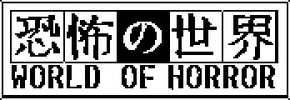 World Of Horror
World Of Horror
Developer: panstasz
Publisher: Ysbryd Games
Platforms: PC
Price: $14.99
Copy Provided By Publisher
Do you like horror games, dear reader? Well I sure don’t, and yet that didn’t stop me from loving World of Horror, a game made by one person and animated completely within MS Paint, so I’m told. Let me be clear here. I’ve survived precious few Resident Evil games. I’ve watched Silent Hill (only watched!) and that was enough for me. I saw the Japanese version of The Grudge in college, and I think I’m still scared. It’s not that I hate horror. I just have no stomach for it.
So, you might be asking, how is it possible that I came across a game I not only sat for a demo on at PAX East this year, not only asked for a review copy of, but then also sat for hours actually enjoying? And without giving myself nightmares! Is it actually scary? Let’s check it out.
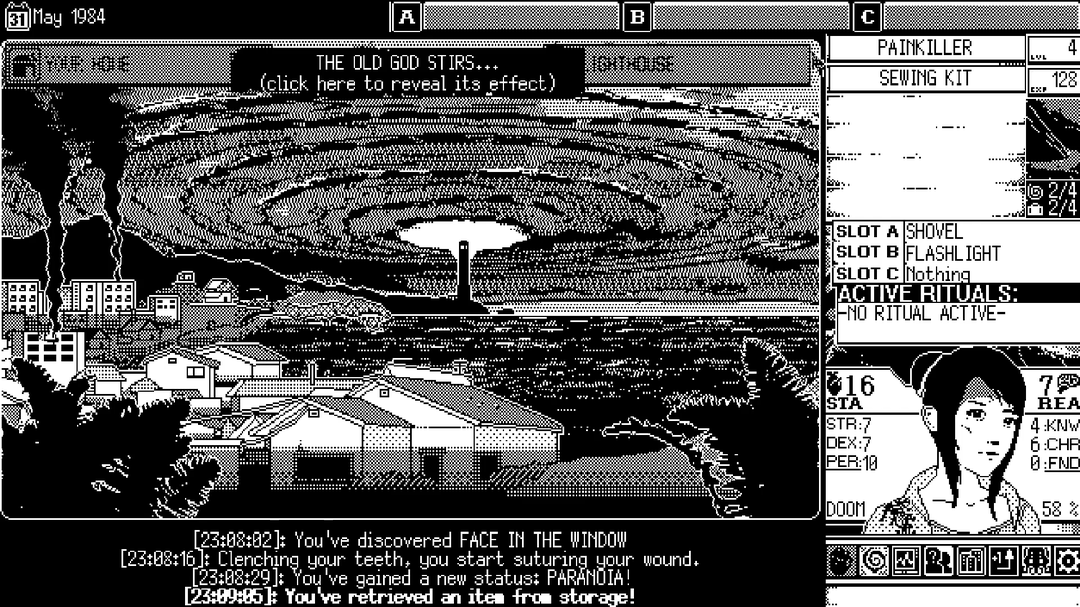
You're about to find out this little seaside town isn't like most others in Japan.
The Appeal
If we’re going to start anywhere with World of Horror, it has to be with its aesthetic. The look and feel of this game are spot on with what you want out of a title like this. Creepy, unsettling, and yet at the same time never overwhelming (depending, more on this in a bit). What we have here, from the developer’s own site, is “a love letter to the cosmic horror work of Junji Ito (伊藤 潤二) and the 1-bit aesthetics of early Macintosh computers.” Seriously, do a Google image search for some of this guy’s work and you’ll see where the game gets its visual inspiration from. Graphics, despite the intentionally pixelated nature of the game, feel detailed and well-made. Both lovingly nostalgic and artistically rendered, they convey the growing dread of the scenes you investigate. As you work your way around the decaying town, you feel the creeping sense of doom. When a monster runs up on you for combat, you feel that immediate need to either bash its face in or nope out as fast as you can. It’s enough to make you recoil in—well—horror.
The game itself is text based and turn based, where actions and consequences, along with combat, progress only once you’ve selected an action (or with combat, queued several actions and hit “launch sequence”). Given the somewhat intense nature of your dwindling health and sanity, as well as a doom counter that’s always ticking up towards the revival of some terrible eldritch god, being able to luxuriate over actions is a pleasant design choice that I think offers respite even in the middle of tense moments. Of course, sometimes the music or persistent sound effects gnaw at you, pushing you to go ahead just a little faster. And I think while I appreciate the game’s pace, those subtle nudges keep the tension at just the right level.
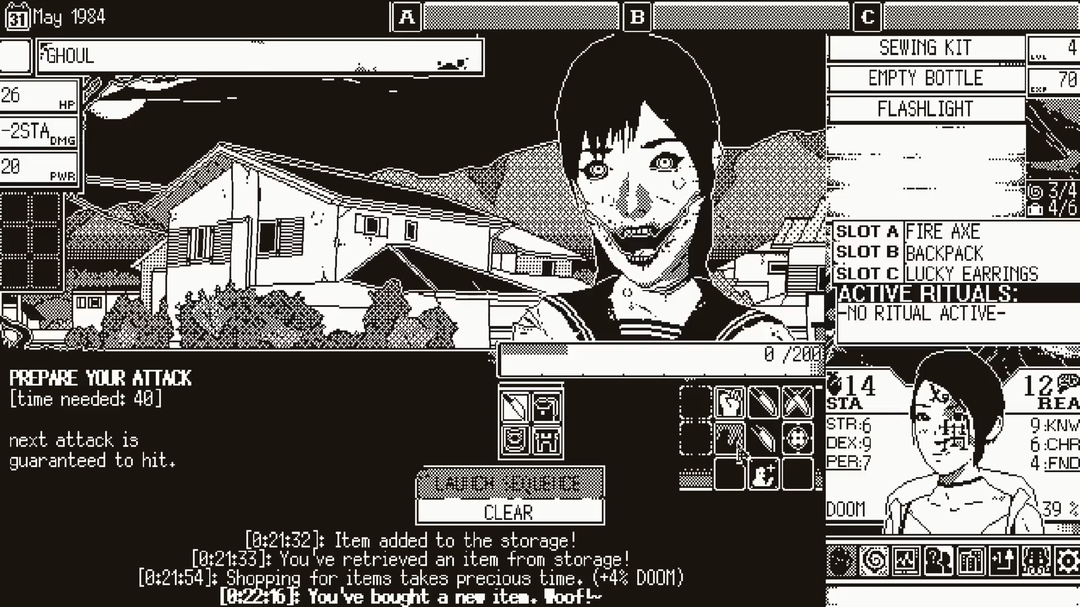
Speaking of things you might need respite from...
In fact, let’s talk about the game’s sound and music. They are, in short, phenomenal. Several folks I’ve shown the game to have commented that the music nails the creep factor the game is trying to convey. Eric specifically noted that while the visuals can be a bit unsettling, in themselves they’re not too bad; but coupled with the music and sound the game kicks up into a whole other level. Sure, you can sit in the empty school classroom as long as you want while the Scissor Lady bangs incessantly on the door. Nothing will progress the game to the combat scene until you’re ready. But the music and that irregular, percussive thumping will make your heart skip a few beats, and at least with my own plays I found myself still clicking through to the next sequence with no lack of urgency.
Not that I’ve seen many Japanese horror movies in my time, but from the ones I remember I will say that this game follows some of the same conventions. It’s not just about seeing the creepy things you’ll have to fight your way past, the ghosts and demons and reanimated dead things (that still look amazing when they do show their faces). It’s also about what you don’t see. It’s about the buildup of tension and dread. It’s about looking out the peek hole on your apartment door into an empty hallway for the 5th time, wondering why this feature is in the game. It’s less about jump scares (though there are occasionally some of those) and more about looking into a strange happening, piecing together bits of a mystery, and slowly realizing just how deep a hole you’ve dropped yourself into. And as the game reveals itself in layers, so too does the gameplay. You’ll learn that you can improvise weapons when you need. You can convince people to join up with you, allies that might pack spells or extra strength, and could at least step in front of a monster for you. You’ll use level ups and items to boost stats, turning failed roll after failed roll into successes and bonuses.
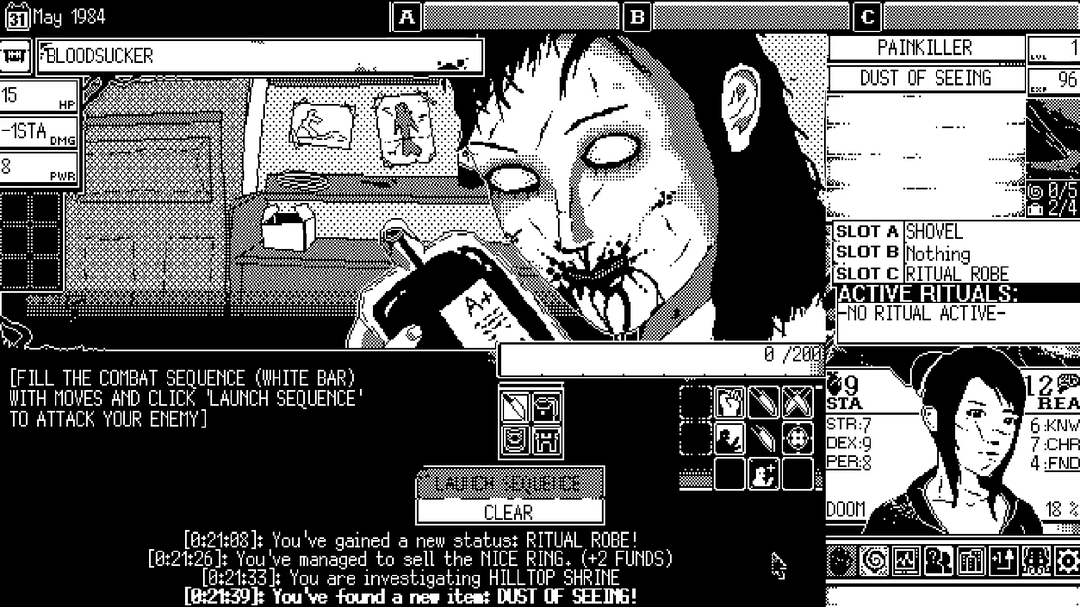
I went to the hospital for some medicine and to patch myself up after a nasty run-in. Didn't expect to find whatever this was!
Just as you’re about to keel over from exhaustion or insanity, you start to bounce back. You’re learning exactly what you’re facing and how to handle it. You walk that tightrope, seeing the light at the other end of the tunnel. And then, perhaps, you still find a creative way to die.
The Mystery
It’s those investigations that drew you to this small, seaside town that will frame your games within World of Horror. In a pleasant rougelite twist, you’ll have 5 missions randomly selected from a pool of (currently) 12, and while the set pieces of each mission will remain static, the random occurrences that happen during the in-betweens are shuffled as well. The result is a surprising balance between keeping things pleasantly unknown while allowing you to learn from your mistakes. Your early explorations will be a blunder of errors and likely result in your death or eventual insanity, but as you continue to play you’ll learn how to better prepare yourself. Perhaps instead of launching directly into an investigation in that school you could’ve checked the lockers for something useful first. Perhaps you’ve learned just how dangerous ghosts can be, so you stock up in the town’s item store before venturing to your point of interest. Maybe you’ve just learned that a good melee weapon is never a bad first move. The slot machine this game provides in its investigations keeps things fresh and tense even as you’re learning to find success where before you found only your demise. And in so doing, this time maybe you’ll figure out that bizarre ritual or learn the weakness of the thing leaving a trail of victims.
The real trick, you’ll soon learn, isn’t just surviving an investigation. If you want to find all the keys that will get you into the lighthouse on the outskirts of town, you’ll need to survive through all five mysteries your game has picked out for you. That’s no easy task when you consider many of them have several endings, further increasing their replayability and ensuring that just because you didn’t get something perfect you didn’t also end your current run. It also means knowing when to return to your apartment for a hot shower and a little R&R. Maybe treating yourself to something to raise that reason score a little bit (your sanity, essentially). How low has your health gotten? Do you need to visit the hospital for medical care? Not pacing myself was definitely what got me killed in my first play through. And this is to say nothing if the effect of your awakening elder god is something like “doom meter increases when you rest at your apartment.” Yeah, that one makes things really interesting.
The Magic
Blend the visual works of Junji Ito with the investigative horror of Call of Cthulhu, frame it the classic look and feel of old school computer games, and give it modern sensibilities like a randomizer to mix up which mysteries/old god you’ll tackle, along with a character select for a variety of play styles, and you’ve got all the elements of World of Horror. But that’s not what makes it special. Not the way characters can be leveled and stats can influence how many actions you can squeeze off in a single combat round. Nor the way the simple button-based interface allows you to cast spells, manage allies, or check status effects and perks of your character. It’s all in how these things come together to form the story the game creates.
Your character arrives in this town fresh and eager. But after one investigation they might no longer have a face. They could be hurt, paranoid, or worse. Thankfully at least you can ready yourself by visiting an appropriate shop in town. Wait, what do you mean the shop closed? The village itself is a character in this story, changing a little bit each time you complete an investigation. And the game will toy with you. Perhaps you’ve arrived early to the next location for your investigations, and you have time to draw a hot bath. Do you take the time, and possibly the risk, to lessen your fatigue? Getting straight to business might lower your doom meter as you don’t “waste time” with non-business things. There are no easy calls in this game, whether to rest or whether to push against that ever increasing doom. Whether to fight or whether to run. Read the flesh bound book or burn it. Use valuable ammo in the gun you found or risk a bare-handed attack so you can save that ammo for later. Cast a spell, costing you valuable reason, or forget it, regaining some. All of these choices make the story your own, and live or die, the final character you end up with feels satisfying.
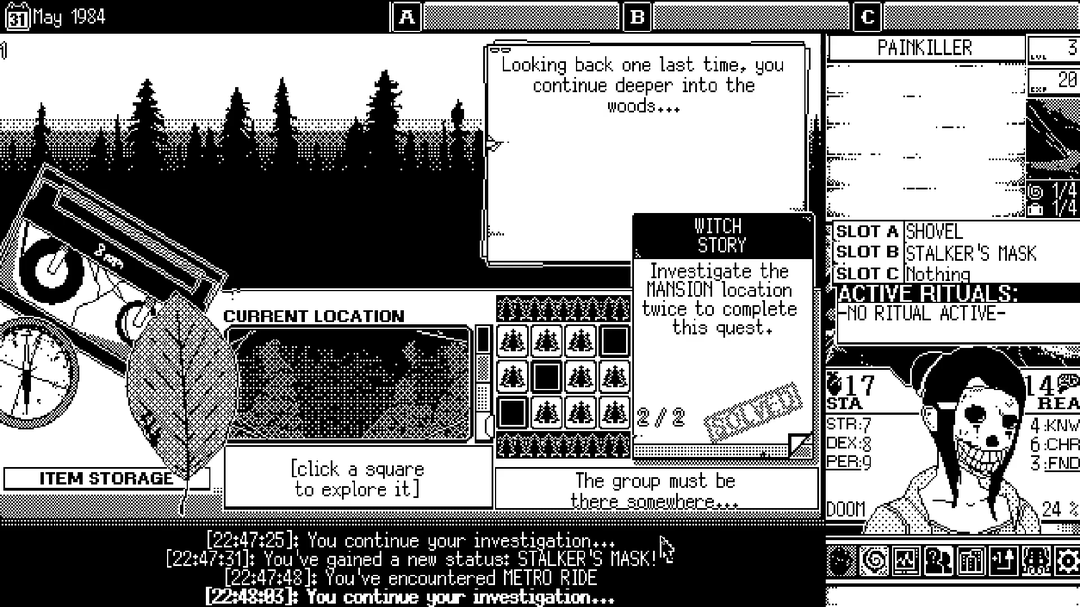
The interface is sometimes a little minigame like this exploration section. It also allows you to move around the town or navigate your options in combat. Your portrait updates as well based on your past investigations and the clothes you change into at your apartment.
I’ll end this review by saying that as brutal as this game can be (and rightly so in fitting with its theme), I never feel like it’s unfair. If I die, I feel that it’s because of something I did. I didn’t prepare well enough. I didn’t practice enough self-care. I pushed too fast or miscalculated the strength of an enemy. And in keeping with that horror feel, runs ending in death or insanity feel like a completely acceptable ending in this little doomed town on the edge of the sea. I’m always looking forward to my next attempt, my next story. Will I get the chance to do better on a mystery, perhaps earning a different ending? I’ll pull that lever one more time.
So who is this game for? The horror lover? The horror hater? How scary is it, and is that a draw or a detractor for you? Honestly that’s a tough call, since we all experience horror on a different scale. I hate horror, generally speaking, and I loved this game. I was never too frightened by it, though still able to experience its thrill. However, some other people that I showed it to said it was still too scary for them (mostly again thanks to the music). Thankfully, there’s a demo you can download on the developer’s site. I’m always a fan of “try before you buy.” It should be noted that some of the images are a little graphic (that is blood and gore, gruesome faces, etc), so take that into account in terms of this game not necessarily being for younger audiences. This game is currently sitting in Steam as early access, and at the price point of $15 it’s in exactly the right place in my opinion. I could still see paying a little more for this title, but the early access discount is a nice thing to see, and there’s a fair amount of replayability on offer.
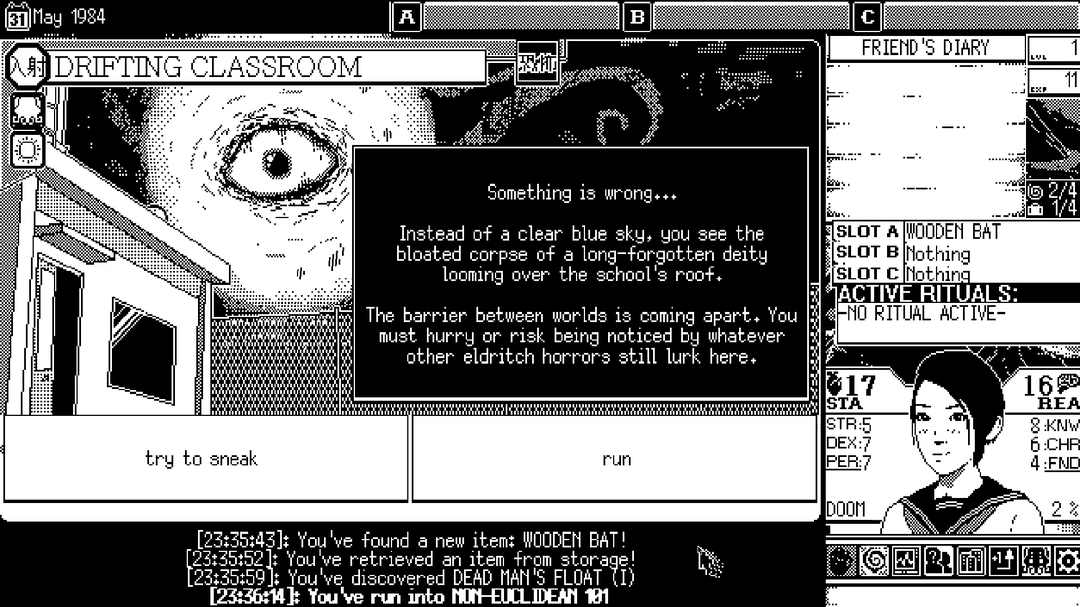
Couldn't let you go from this review without another oddly unsettling scene you might be (un)fortunate to come across!
Finally, I think adventure game fans will love this game as long as they can get past that aforementioned horror aspect; folks who love that Call of Cthulhu feel will also be right at home here. If any of this sounds even remotely interesting to you, then this is definitely one little indie game you won’t want to miss!